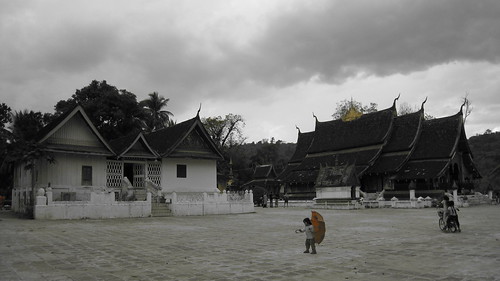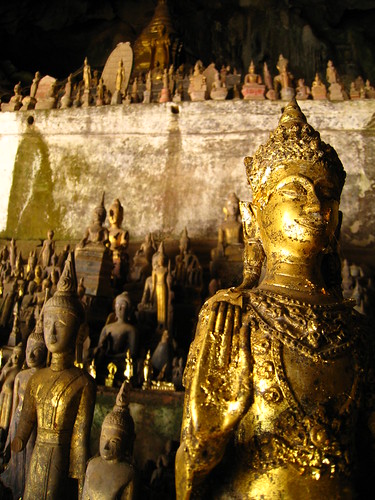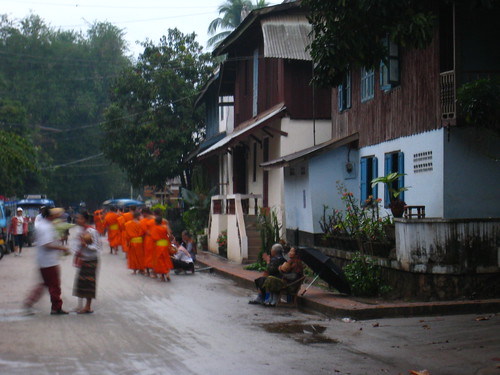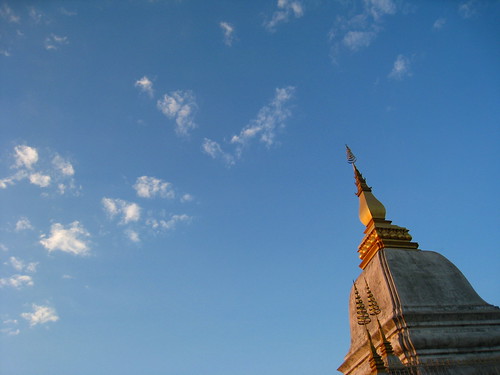 Luang Prabang was declared a UNESCO World Heritage Site in 1995. UNESCO described the city as "an outstanding example of the fusion of traditional architecture and Lao urban structures with those built by the European colonial authorities in the 19th and 20th centuries. Its unique, remarkably well-preserved townscape illustrates a key stage in the blending of these two distinct cultural traditions."
Luang Prabang was declared a UNESCO World Heritage Site in 1995. UNESCO described the city as "an outstanding example of the fusion of traditional architecture and Lao urban structures with those built by the European colonial authorities in the 19th and 20th centuries. Its unique, remarkably well-preserved townscape illustrates a key stage in the blending of these two distinct cultural traditions."  The delight of Luang Prabang is wandering around the colonial building lined streets and popping into the myriad of temples. Luang Prabang is packed with temples and monks. One of the most atmospheric things you can do is watch the line of saffron clad monks collect alms at dawn. (Although if you read this article on Wikitravel even this act may have been corrupted by tourism.)Wat Xieng Thong is the prettiest of the temples, so pretty in fact that when the Chinese invaded they didn't burn it down. Wat Xieng Thong is at the north of the peninsula and if you cary on walking down to the river you will come across a bamboo bridge that the locals have made. They charge a 4,000 Kip toll. On the headland is a very basic cafe, which has sweeping views over the Mekong and mud flats. When I was there it was full of kids flying kites. Also on the other side of the bridge is Ban Xieng Lak a weaving village. A great place to get a view over Luang Prabang is from Wat Phu Si. The views are great although it does get very busy at sunset. The Royal Palace Museum is a great peak inside the former life of the Lao Royal Family. The throne room is especially pretty covered in multi-coloured glass tiles.
The delight of Luang Prabang is wandering around the colonial building lined streets and popping into the myriad of temples. Luang Prabang is packed with temples and monks. One of the most atmospheric things you can do is watch the line of saffron clad monks collect alms at dawn. (Although if you read this article on Wikitravel even this act may have been corrupted by tourism.)Wat Xieng Thong is the prettiest of the temples, so pretty in fact that when the Chinese invaded they didn't burn it down. Wat Xieng Thong is at the north of the peninsula and if you cary on walking down to the river you will come across a bamboo bridge that the locals have made. They charge a 4,000 Kip toll. On the headland is a very basic cafe, which has sweeping views over the Mekong and mud flats. When I was there it was full of kids flying kites. Also on the other side of the bridge is Ban Xieng Lak a weaving village. A great place to get a view over Luang Prabang is from Wat Phu Si. The views are great although it does get very busy at sunset. The Royal Palace Museum is a great peak inside the former life of the Lao Royal Family. The throne room is especially pretty covered in multi-coloured glass tiles. I did the Pak Ou trip from Luang Prabang. It is a two hour cruise up the Mekong to the Pak Ou caves where there are two caves full of Buddha statues. On the way back you stop at Ban Sang Hai where they make rice whiskey. The cruise along the Mekong is the best part of the trip, although the cloud and mist didn't begin to clear until about 11am. On the way back the sun had burnt the cloud layer and it made for a much more picturesque journey. It is amazing how unpopulated the area is and as you cruise along you only come across occasional breaks in the tree line where villages sit. The caves themselves are not that spectacular. The first cave next to the river is the most atmospheric. There are swarms of children selling stones and birds in cages on the way up to the second cave. I paid 70,000 Kip for the trip at Luang Prabang Travel and Tours (next to the main boat ramp behind the Royal Palace Museum). Once you get to the caves there is a 20,000 Kip entry fee.
I did the Pak Ou trip from Luang Prabang. It is a two hour cruise up the Mekong to the Pak Ou caves where there are two caves full of Buddha statues. On the way back you stop at Ban Sang Hai where they make rice whiskey. The cruise along the Mekong is the best part of the trip, although the cloud and mist didn't begin to clear until about 11am. On the way back the sun had burnt the cloud layer and it made for a much more picturesque journey. It is amazing how unpopulated the area is and as you cruise along you only come across occasional breaks in the tree line where villages sit. The caves themselves are not that spectacular. The first cave next to the river is the most atmospheric. There are swarms of children selling stones and birds in cages on the way up to the second cave. I paid 70,000 Kip for the trip at Luang Prabang Travel and Tours (next to the main boat ramp behind the Royal Palace Museum). Once you get to the caves there is a 20,000 Kip entry fee. Kwang Si Falls is stunningly beautiful. If you can only do one trip in Luang Prabang I would recommend this over Pak Ou caves. There are a number of small pools and rapids. The main attraction are the very high falls broken by pools midway down. It is possible to climb up to this first of pools. It is also possible, and well worth, climbing to the very top of the waterfall. From here you can walk across the top of the waterfall (probably not the best idea in the wet season). I did an afternoon trip in the back of a packed Jumbo for 45,000 Kip.
 The people of Luang Prabang are generally very nice and friendly. However, it would be naive to think that the amount of tourists and money coming in to Luang Prabang would not have had an effect, I was chatting to a Canadian in Oudomxai who had been travelling for a number of years in Asia. He described the change as one where the local people move from a position of deference to the westerner to one of indifference and then contempt. While this wasn't a big problem in Luang Prabang it was still the most touristy place I visited in Laos other than Vang Vieng or Don Det. There were groups of kids, especially around the entrances to Wat Phu Si who were trying to sell you things and there was a little bit of begging. The 'high-class' tourists have made Luang Prabang touristy but not by bringing everything down to the lowest common denominator like Vang Vieng and Don Det. UNESCO World Heritage listing has made Luang Prabang even more popular as a tourist destination but it has also protected the city from some of the more ugly building developments in other parts of Laos.
The people of Luang Prabang are generally very nice and friendly. However, it would be naive to think that the amount of tourists and money coming in to Luang Prabang would not have had an effect, I was chatting to a Canadian in Oudomxai who had been travelling for a number of years in Asia. He described the change as one where the local people move from a position of deference to the westerner to one of indifference and then contempt. While this wasn't a big problem in Luang Prabang it was still the most touristy place I visited in Laos other than Vang Vieng or Don Det. There were groups of kids, especially around the entrances to Wat Phu Si who were trying to sell you things and there was a little bit of begging. The 'high-class' tourists have made Luang Prabang touristy but not by bringing everything down to the lowest common denominator like Vang Vieng and Don Det. UNESCO World Heritage listing has made Luang Prabang even more popular as a tourist destination but it has also protected the city from some of the more ugly building developments in other parts of Laos. The main tourists in Luang Prabang are middle aged or older. There are lots of North Americans and French. I have never come across as many French outside of France before. Luang Prabang is not dominated by backpackers, which has its advantages. There isn't a plethora of cheap bars. There are some very expensive looking restaurants and cafes, trading on the chic of the French colonial buildings. These establishments are very cheap by Western standards but an arm and aleg by Laos standards. It is more than possible to eat cheaply in Luang Prabang, there are the cheap noodle shops and in the night market is a stall where for 5,000 Kip you can fill a bowl with as many noodles and as much vegetables as you want (although I'm pretty sure I got food poisoning here). Accommodation is also more expensive than the test of Laos. I had been paying 60,000 Kip for a double with ensuite hot shower and sometimes a TV. In Luang Prabang the equivalent was 100,000 to 120,000 Kip. I paid 60,000 Kip at Merry Guesthouse 2 for a twin with shared bathroom. It was OK but nothing special, the shoe rack was always full so I think alot of people had to settle for it. Merry Guesthouse 2 is quite noisy due to the family who own it. There are, like the restaurants, expensive boutique hotel options as well.
The main tourists in Luang Prabang are middle aged or older. There are lots of North Americans and French. I have never come across as many French outside of France before. Luang Prabang is not dominated by backpackers, which has its advantages. There isn't a plethora of cheap bars. There are some very expensive looking restaurants and cafes, trading on the chic of the French colonial buildings. These establishments are very cheap by Western standards but an arm and aleg by Laos standards. It is more than possible to eat cheaply in Luang Prabang, there are the cheap noodle shops and in the night market is a stall where for 5,000 Kip you can fill a bowl with as many noodles and as much vegetables as you want (although I'm pretty sure I got food poisoning here). Accommodation is also more expensive than the test of Laos. I had been paying 60,000 Kip for a double with ensuite hot shower and sometimes a TV. In Luang Prabang the equivalent was 100,000 to 120,000 Kip. I paid 60,000 Kip at Merry Guesthouse 2 for a twin with shared bathroom. It was OK but nothing special, the shoe rack was always full so I think alot of people had to settle for it. Merry Guesthouse 2 is quite noisy due to the family who own it. There are, like the restaurants, expensive boutique hotel options as well.  I arrived in Luang Prabang by bus from Oudomxai. I had stopped in Oudomxai to break up the journey to Luang Prabang from Luang Nam Tha. It was four hours sitting on a plstic stool in the aisle of the bus over bumpy gravel roads going up and down hill sides from Luang Nam Tha to Oudomxai. The road from Oudomxai to Luang Prabang is much better quality, though it still takes five hours. I stayed at Lithavixay Guesthouse, it was 60,000 Kip for a double with hot ensuite and TV. There isn't a great deal to do in Oudomxai. At sunset it seems all the tourists in town head up to Phu That on a hill in the centre of town. There is also the bust of Kaysone Phomvihane. Kaysone Phomvihane was the leader of the Laos PDR from 1975 until his death in 1992. These busts are in every town in Laos in the most out of the way places. They appear to be shiny and new and yet forgotten. Apparently after his death North Korea donated 50 busts to Laos. One of the tricks to travelling in northern Laos is arriving early for your bus. Often the buses leave before 7am. Generally there is one bus in the morning (maybe two) and they are normally packed. The locals get there early to make sure they get on, so even if you have a ticket you are not guaranteed a seat. The bus station in Oudomxai, surprisingly for Laos, is near the centre of town, so you don't need to get a tuk-tuk there or back. Unlike in Luang Prabang where its another 10,000 Kip share tuk-tuk into town. I got to the bus an hour before departure and got one of the last seats. With half an hour to go it filled until there was no space left on board. People were squeezed down the aisle and around the driver. After a couple of hours we had a toilet break and I got chatting to the driver who spoke perfect English. It turned out he had a passion for magicians and seemed delighted to be able to talk to a native English speaker about them. He hadn't heard of Paul Daniels.
I arrived in Luang Prabang by bus from Oudomxai. I had stopped in Oudomxai to break up the journey to Luang Prabang from Luang Nam Tha. It was four hours sitting on a plstic stool in the aisle of the bus over bumpy gravel roads going up and down hill sides from Luang Nam Tha to Oudomxai. The road from Oudomxai to Luang Prabang is much better quality, though it still takes five hours. I stayed at Lithavixay Guesthouse, it was 60,000 Kip for a double with hot ensuite and TV. There isn't a great deal to do in Oudomxai. At sunset it seems all the tourists in town head up to Phu That on a hill in the centre of town. There is also the bust of Kaysone Phomvihane. Kaysone Phomvihane was the leader of the Laos PDR from 1975 until his death in 1992. These busts are in every town in Laos in the most out of the way places. They appear to be shiny and new and yet forgotten. Apparently after his death North Korea donated 50 busts to Laos. One of the tricks to travelling in northern Laos is arriving early for your bus. Often the buses leave before 7am. Generally there is one bus in the morning (maybe two) and they are normally packed. The locals get there early to make sure they get on, so even if you have a ticket you are not guaranteed a seat. The bus station in Oudomxai, surprisingly for Laos, is near the centre of town, so you don't need to get a tuk-tuk there or back. Unlike in Luang Prabang where its another 10,000 Kip share tuk-tuk into town. I got to the bus an hour before departure and got one of the last seats. With half an hour to go it filled until there was no space left on board. People were squeezed down the aisle and around the driver. After a couple of hours we had a toilet break and I got chatting to the driver who spoke perfect English. It turned out he had a passion for magicians and seemed delighted to be able to talk to a native English speaker about them. He hadn't heard of Paul Daniels.
No comments:
Post a Comment